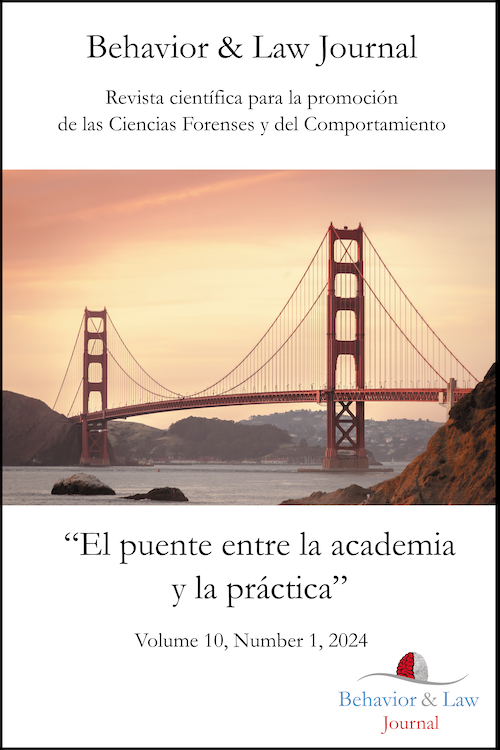Abstract
Criminology and forensic sciences have developed with society itself. In this review and analysis article, we try to get involved in a very important and topical topic, such as the fundamental work of the Criminalistics and Forensic Sciences Laboratories, in the consolidation of justice, helping society feel legally safer. Since the very emergence of Criminalistics, until today, the different techniques have been constantly improved, always with the primary objective of achieving the clarification of criminal facts. Highlighting in this investigation is the foundation of the Criminalistics Laboratories, in carrying out expert reports in different areas of science, based on the incidents found in the place where possibly, given the findings, a crime had been perpetrated. The use of different scientifically based techniques for the processing of this evidence, collected from the inspection of the scene. We will make a description of the fundamental subjects in which we work, such as technical visual inspection; fingerprinting; legal Medicine; Ballistics; anthropology; forensic genetics; documentology; papilloscopy, necroidentity; forensic telematics computer forensics audio, video and related; marking analysis, forensic mechanical damage assessment and post blast investigation. And in a practical way, the work will also demonstrate the effectiveness of having these laboratories. An important bibliographic review was carried out and the analysis of a case, which demonstrated what was described, and which led us to the conclusions reached.
References
¿Qué es la Ciencia Forense? (s.f.). [Película]. Obtenido de https://youtu.be/XC55DnXUZzM
Barroso, D. (Dirección). (2021). Origen de la Criminalística [Película]. Obtenido de https://youtu.be/N2xa8vPbZZo
Campos, R. (08 de 06 de 2016). Ministerio de Gobierno. Recuperado el 20 de 07 de 2023, de https://www.ministeriodegobierno.gob.ec/criminalistica-fortalece-conocimientos-en-proteccion-de-escena-del-crimen-a-policias-de-la-zona-8/#
Cardoso, C. H. (2018). Universidad de Granada. Obtenido de https://digibug.ugr.es/bitstream/handle/10481/51603/TFG%20Digibug.pdf?sequence=1&isAllowed=y#:~:text=La%20Criminal%C3%ADstica%20de%20campo%20se,su%20naturaleza%2C%20convirti%C3%A9ndolos%20en%20evidencias.
Correa Delgado, R. (1 de marzo de 2016). Consejo de la Judicatura. Obtenido de https://guayas.funcionjudicial.gob.ec/index.php?option=com_content&view=article&id=871:moderno-laboratorio-de-criminalistica-pone-a-ecuador-a-la-vanguardia-de-las-ciencias-forenses&catid=14:noticias-home
Eche Salvatierra, R. A., Martínez Chávez, R. E., & Cedeño Cedeño, M. A. (2023). Importancia de la medicina legal y forense en la investigación de los hechos violentos. RECIAMUC, 544-556. doi:10.26820/reciamuc/7
Franco, E. (s.f.). Recuperado el 08 de 08 de 2023, de https://es.scribd.com/document/289013052/Evolucion-de-La-Criminalistica-en-El-Ecuador
Garrido, E. N. (10 de 09 de 2021). Obtenido de https://es.scribd.com/document/532743820/Historia-de-La-Criminalistica-en-Ecuador
González, R. M. (1997). LA CRIMINALÍSTICA Y LA CRIMINOLOGÍA, AUXILIARES DE LA JUSTICIA. En Varios, El Ministerio Público en el Distrito Federal. INSTITUTO DE INVESTIGACIONES JURÍDICAS. Recuperado el 08 de 08 de 2023, de https://goo.gl/4X2Cbs
Gross, H. (1893). Manual del Juez como sistema de Criminalística. Madrid: La España Moderna. Obtenido de https://www.academia.edu/40664671/Hans_Gross_Manual_del_juez_de_instruccion
Herrera, J. L. (20 de 04 de 2021). Derecho Informático. Recuperado el 30 de 07 de 2023, de https://derechoinformatico.gt/evidencia-digital-un-producto-de-la-informatica-forense/
Luna Leyva, P. (08 de Julio de 2020). Preservación del lugar de los hechos. Foro Jurídico. Obtenido de https://forojuridico.mx/preservacion-del-lugar-de-los-hechos/
Nacional, A. (2014). Código Orgánico Integral Penal. Ecuador. Obtenido de https://www.defensa.gob.ec/wp-content/uploads/downloads/2021/03/COIP_act_feb-2021.pdf
Nacional, A. (2014). defensa.gob.ec. Obtenido de https://www.defensa.gob.ec/wp-content/uploads/downloads/2021/03/COIP_act_feb-2021.pdf
Nacional, G. (s.f.). Ciencias Forenses. Recuperado el 08 de 08 de 2023, de https://www.cienciasforenses.gob.ec/laboratorio-de-criminalistica-y-ciencias-forenses-brinda-un-adecuado-servicio-en-medicina-legal/
Nacional, G. (s.f.). Ministerio de Gobierno. Recuperado el 08 de 08 de 2023, de https://www.ministeriodegobierno.gob.ec/laboratorio-de-criminalistica-y-ciencias-forenses-punto-de-encuentro-tecnico-cientifico/
Naciones Unidad, O. (2017). Protocolo de Minnesota sobre la investigación de muertes potencialmente ilícitas. Obtenido de https://www.ohchr.org/sites/default/files/Documents/Publications/MinnesotaProtocol_SP.pdf
Solano Gutiérrez, F. N., & Espinosa Hinojosa, C. D. (2017). La importancia de la inspección ocular técnica como factor determinante en la calidad de la investigación en la escena del delito y su relevancia en el nuevo proceso adversarial oral ecuatoriano. Repositorio Digital - Universidad Nacional de Loja. Obtenido de https://dspace.unl.edu.ec/jspui/handle/123456789/19095
Torales, E. (2017). Manual de actuación en el lugar del hecho y/o escena del delito. Autónoma de Buenos Aires, Argentina: SAIJ.
U-Hemisferios. (s.f.). Universidad de los Hemisferios. Recuperado el 08 de 08 de 2023, de https://globalimf.com.ec/uhemisferios/blog/la-criminalistica-y-su-aporte-a-la-investigacion-policial/
Varela, E. (22 de abril de 2017). Aquí se habla Derecho. Obtenido de https://aquisehabladerecho.com/2017/04/22/resumen-historico-de-la-criminalistica/#:~:text=La%20criminal%C3%ADstica%20surge%20como%20derivaci%C3%B3n,criminal%C3%ADstica%20es%20la%20denominada%20dactiloscopia.
Wertheim, K., Barnes, J., & Otros. (2002). El libro de referencia de las huellas dactilares. (A. McRoberts, Ed.) Washington, EEUU: Instituto Nacional de Justicia. Recuperado el 31 de 07 de 2023, de https://www.ojp.gov/pdffiles1/nij/249575.pdf

This work is licensed under a Creative Commons Attribution-NonCommercial-NoDerivatives 4.0 International License.
Copyright (c) 2024 Behavior & Law Journal

